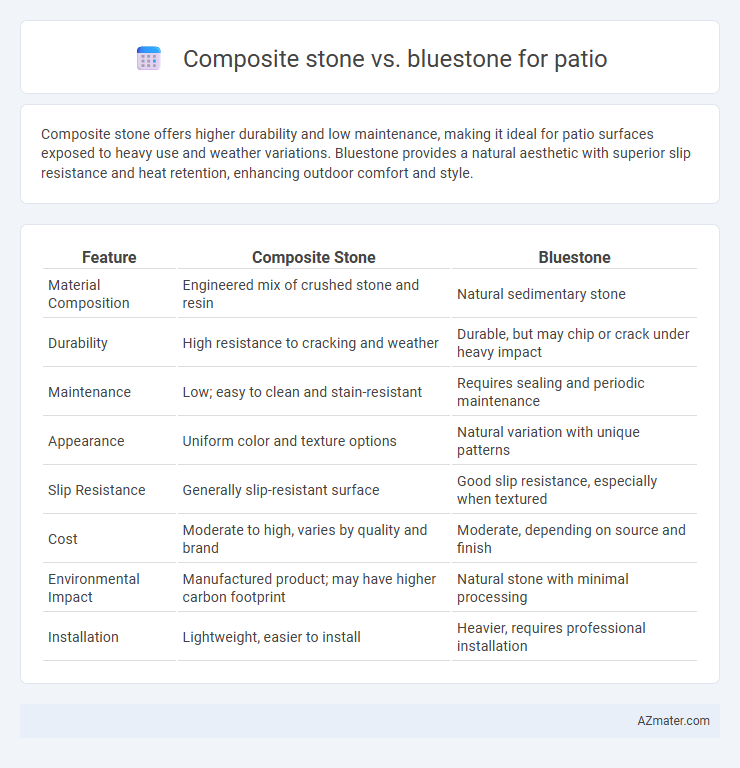Composite stone offers higher durability and low maintenance, making it ideal for patio surfaces exposed to heavy use and weather variations. Bluestone provides a natural aesthetic with superior slip resistance and heat retention, enhancing outdoor comfort and style.
Table of Comparison
| Feature | Composite Stone | Bluestone |
|---|---|---|
| Material Composition | Engineered mix of crushed stone and resin | Natural sedimentary stone |
| Durability | High resistance to cracking and weather | Durable, but may chip or crack under heavy impact |
| Maintenance | Low; easy to clean and stain-resistant | Requires sealing and periodic maintenance |
| Appearance | Uniform color and texture options | Natural variation with unique patterns |
| Slip Resistance | Generally slip-resistant surface | Good slip resistance, especially when textured |
| Cost | Moderate to high, varies by quality and brand | Moderate, depending on source and finish |
| Environmental Impact | Manufactured product; may have higher carbon footprint | Natural stone with minimal processing |
| Installation | Lightweight, easier to install | Heavier, requires professional installation |
Introduction to Patio Stone Options
Composite stone offers a durable, low-maintenance option for patios, combining natural stone with resin for enhanced strength and weather resistance. Bluestone, a natural quarried stone known for its rich blue-gray hues and textured surface, provides a classic and elegant appearance ideal for traditional and contemporary outdoor spaces. Both materials vary in cost, installation complexity, and longevity, making it crucial to assess climate, aesthetic preferences, and budget when choosing the perfect patio stone.
What is Composite Stone?
Composite stone is an engineered material made from a blend of crushed natural stone, resin, and pigments, designed to mimic the appearance and durability of natural stone while offering enhanced strength and weather resistance. It provides a consistent color and texture, making it ideal for patio applications where uniformity and low maintenance are desired. Bluestone, a natural sedimentary rock with unique variations and a distinctive blue-gray hue, contrasts with composite stone by offering authentic natural aesthetics but typically requires more upkeep.
What is Bluestone?
Bluestone is a natural sedimentary rock known for its durability, rich blue-gray color, and unique texture, making it a popular choice for patios and outdoor landscapes. Unlike composite stone, which is manufactured using a blend of materials to mimic natural stone, bluestone is quarried directly from the earth, offering authentic, non-porous surface qualities ideal for wet climates. Its dense composition resists chipping and weathering, providing long-lasting beauty and requiring minimal maintenance compared to engineered alternatives.
Appearance and Design Versatility
Composite stone offers a sleek and uniform appearance with the ability to mimic natural stone while providing consistent color and texture, enhancing modern patio designs. Bluestone features a naturally rugged surface with rich blue-gray hues and unique veining, adding authentic character and timeless elegance to outdoor spaces. Design versatility is higher in composite stone due to customizable shapes, sizes, and color options, whereas bluestone's organic variations suit traditional and rustic aesthetics.
Durability and Lifespan Comparison
Composite stone patios offer superior durability due to their resistance to cracking, fading, and weather damage, often lasting 20 to 30 years with minimal maintenance. Bluestone, a natural sedimentary stone, provides a lifespan of around 30 years but is more susceptible to chipping and weathering over time. Choosing composite stone ensures longer-lasting performance and less upkeep, while bluestone requires periodic sealing to maintain its durability.
Maintenance Requirements
Composite stone patios demand minimal maintenance, requiring only occasional cleaning with soap and water to prevent dirt buildup and maintain appearance. Bluestone patios, composed of natural stone, need regular sealing every 1-2 years to protect against stains, weathering, and moss growth. The porous nature of bluestone makes it more susceptible to cracks and discoloration if not properly maintained, whereas composite stone offers enhanced durability and resistance to fading and mildew.
Cost Analysis: Composite Stone vs Bluestone
Composite stone patios typically cost between $7 and $15 per square foot, offering a budget-friendly alternative to bluestone, which ranges from $15 to $30 per square foot depending on quality and region. Installation expenses for composite stone are lower due to easier handling and uniform slabs, while bluestone requires skilled labor and time-intensive preparation, increasing overall costs. Maintenance costs also differ; composite stone demands minimal upkeep, whereas bluestone may require periodic sealing and repairs, influencing long-term affordability.
Installation Process and Complexity
Composite stone patios feature interlocking panels or pavers that simplify installation with uniform shapes and lightweight materials, reducing labor time and the need for specialized tools. Bluestone requires skilled masonry work due to its natural, irregular shapes and heavier weight, demanding precise cutting and fitting to achieve a seamless layout. The complexity of bluestone installation often increases project duration and cost compared to the more straightforward, DIY-friendly composite stone option.
Environmental Impact and Sustainability
Composite stone patios often utilize recycled materials such as plastic and wood fibers, reducing landfill waste and conserving natural resources, which enhances their sustainability. Bluestone, a natural sedimentary rock, is quarried from the earth, leading to higher environmental disturbances and energy consumption during extraction and transport. Choosing composite stone can result in a lower carbon footprint and more eco-friendly patio solution compared to traditional bluestone options.
Which Patio Stone is Best for You?
Composite stone offers exceptional durability and low maintenance, making it ideal for patios exposed to varying weather conditions and heavy foot traffic. Bluestone provides natural beauty and a unique, textured surface that enhances outdoor aesthetics, perfect for homeowners seeking an authentic, classic look. Choosing the best patio stone depends on priorities such as maintenance commitment, budget, and desired visual appeal.

Infographic: Composite stone vs Bluestone for Patio
 azmater.com
azmater.com